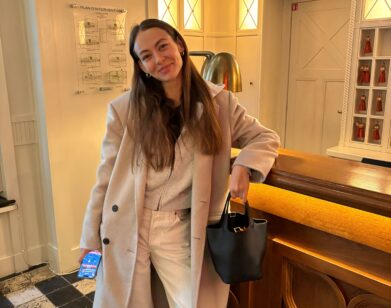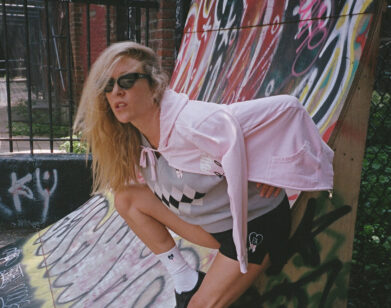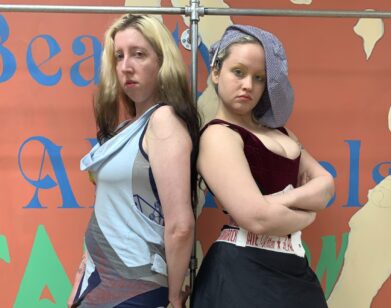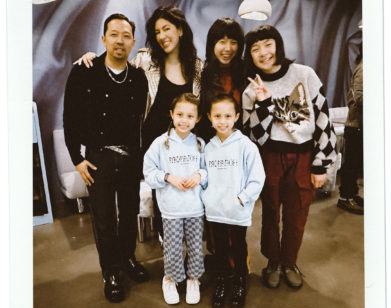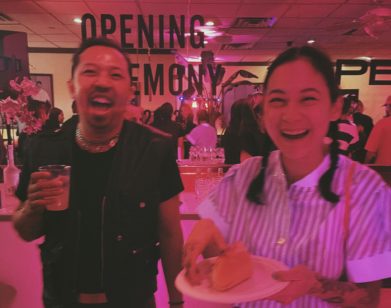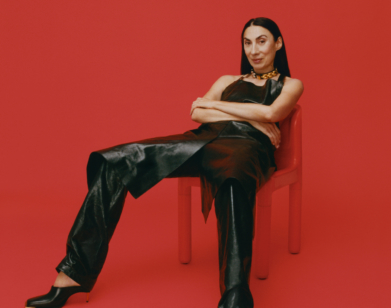How Café Forgot is Healing New York’s Retail Landscape
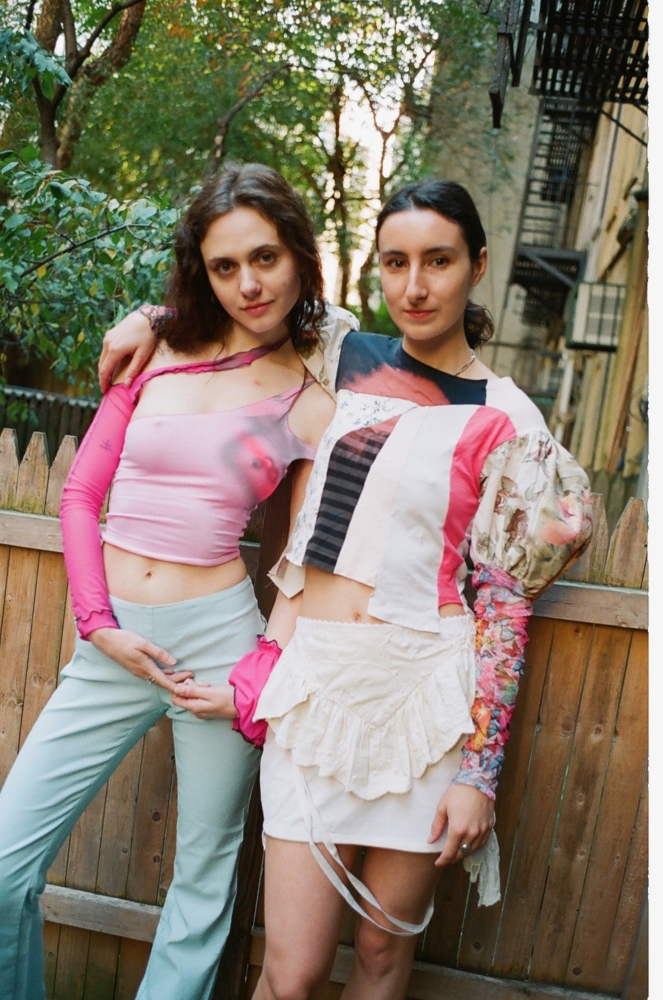
Lucy’s Shirt (Right) by Kristin Mallison. Vita’s Shirt (Left) by Merritt. Both Bottoms by Martina Cox. All Photos by Christian De Fonte.
I received word via Instagram DM about Café Forgot from a friend in California—an impressive transnational reach for a brand without an official storefront. Conceptualized by way of daydreams at Reed College, the retailer was launched in 2017 by Vita Haas and Lucy Weisner when they moved back to their native Manhattan. Café is a nomadic shop that has appeared in different venues across the country for varying periods over the past two years. As a community-based retail experience, Haas and Weisner’s concept evokes the ethos of Opening Ceremony—the clothing store as sacred gathering place—while revising it. Without e-commerce, Café’s storefront necessitates community. (The only thing you can find online is their calendar.)
The current state of retail can make it difficult to luxuriate: in our time, with our friends, and on single pieces of good clothing. Thankfully, Café Forgot is here to help heal weary consumers. Part of this healing happens through the shop’s pieces, too strange and wonderful not to relish at length, like the pants of Martina Cox, complete with a plastic-covered window to the ass, or the chains of Marland Backus, covered in metal detritus. Another aim of Café is to detoxify the retail space and establish it as one of joy; Haas and Weisner have invited shoppers to comedy shows, wine nights, and a three-part concert in their various locations. Now on their ninth and longest-running space–their storefront on East Sixth Street will take them through the end of this year—the two architects of Café Forgot sat down to discuss the ever-traveling pop-up shop method, and what it brings to an atomized city like New York.
———
BESSIE RUBINSTEIN: Café Forgot took a hiatus during January. What did you take from its fledgling season, and what do you want to change for its return, if anything?
LUCY WEISNER: Well, I feel like I’ve realized it’s been working. This is our first time having a more permanent space. We’ve been working in this kind of temporary format, and we’ve realized how successful that can be, because it feels like it keeps things really new every time. And it kind of just works with the way we’re organized. I think we offer it more similarly to a gallery, where we kind of close and reopen, and we can give designers back things that don’t sell and then ask for new things. And we’re always keeping it fresh, so we’re not burdened with merchandise if it doesn’t sell. In January, we did one breath-work class that we hosted with our friend [New York-based Luke Simon]—he taught it, but we kind of just spent the month organizing the year and using this space as more of a studio.
RUBINSTEIN: Your programming does incorporate esoteric medicine and healing. Are you spiritual?
WEISNER: A lot of the designers and clothes that we work with kind of incorporate elements of healing practices into their work. We’re working with this girl who is based in Berlin right now, and she’s designing a special collection for Café. Over the summer, at our last store, we had this survey where it was asking people about their chakras. And now she’s designing a collection based on those survey results.
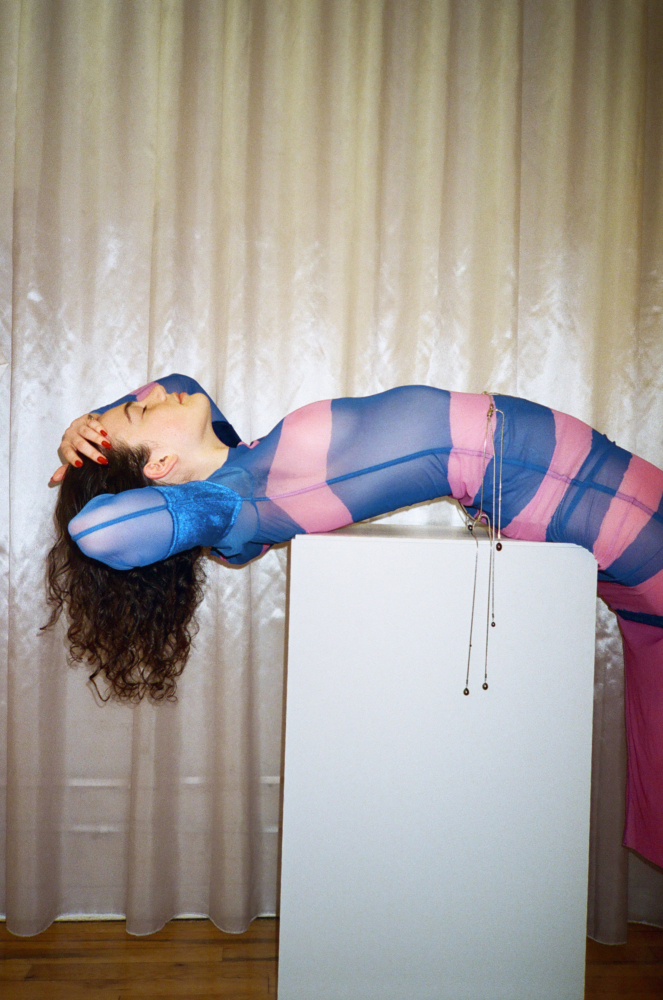
Chain by Marland Backus. Dress by Ignacia Zordan.
RUBINSTEIN: In addition to community building and curating, do either of you have other creative practices?
VITA HAAS: Part of the reason that we really like doing programming is because we do have other interests, like, I personally really love figure-drawing but not in a way that’s at all career-oriented. I really got a lot of joy from drawing from life, so we’re going to have a figure-drawing class in the summer. I really like music, and I was in a band in college, and we had a punk show. I read a lot, so we’re going to have a book club. We just want it to become a space where people can pursue all sorts of creative interests.
RUBINSTEIN: How do you see this project in terms of the conversation about sustainability in fashion?
WEISNER: By the nature of how a lot of our designers operate—they don’t produce whole fall collections, or they produce one of a kind of pieces, or they really emphasize up-cycling—it’s very much in line with a new sort of sustainable thinking. That’s really important to us because fast fashion is such a polluting industry.
RUBINSTEIN: You also know exactly where you’re clothes are coming from, and from whose labor—how the pieces are being produced—because many of the designers are your friends, right? I know you both are from New York originally. Is there something about this city that was conducive to this project? The concentration of talent?
HAAS: I think New York is really diverse in a lot of ways. But it’s also expensive, which makes it hard to be making your own work. You have to do other jobs. So I think that was an important thing about the whole thing—when we first started, we had friends that were making things, but didn’t necessarily have a place to show their work. And I think it’s important to provide that platform, especially in a place like this. There are so many talented people, but they’re working for maybe another designer where they can’t produce their own line with their own collection, and do that production. So it was cool that we could be like, “Well, we can take your pieces.”
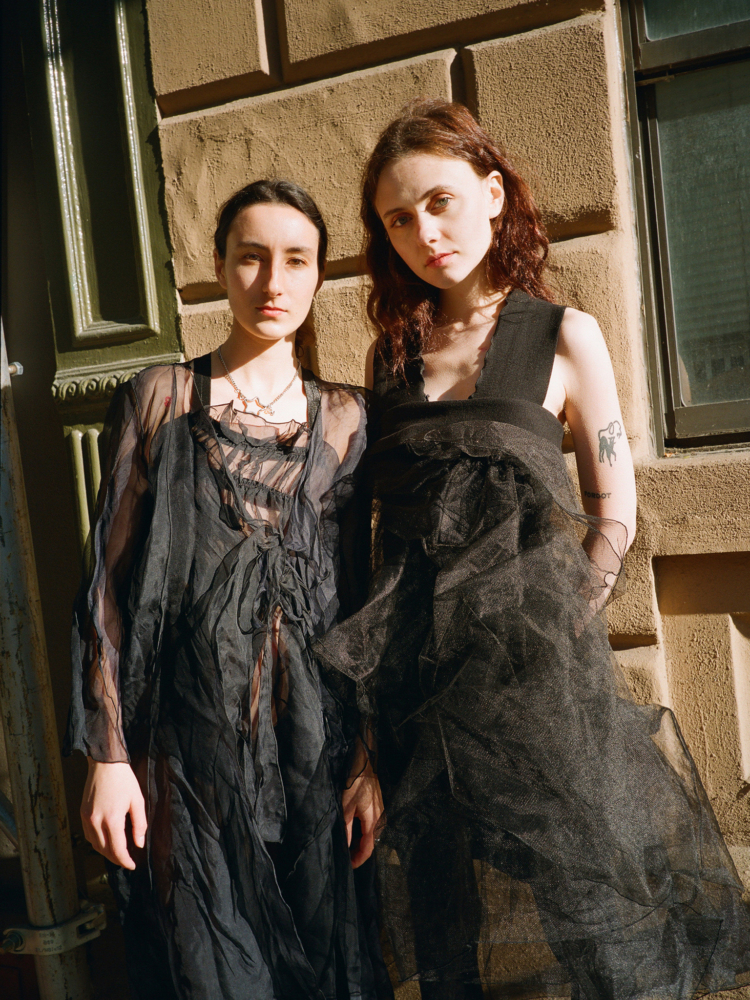
Clothes by Sherris.
RUBINSTEIN: At least one of your pop-ups was in a gallery, and you both majored in art history. Do either of you have an opinion on fashion in museum institutions? Do you think it gets proper representation?
HAAS: Fashion in general is interesting to me, because it’s this super kind of consumable medium and often is not approached critically. And I think what is interesting about seeing fashion in more of a museum or art context is that there’s room for that critical lens. I think it’s fitting with the way we approach Café Forgot conceptually. In art history, there’s so many conversations about this kind of dichotomy between art, and fine art versus craft, and how that can be such a gender distinction too.
RUBINSTEIN: Is Café doing anything romantic for February? Anything cheesy?
HAAS: I think a lot of our items, especially jewelry, are romantic, childish, have hearts and very feminine, playful colors. So it’s fun to sort of encourage our designers to bear that in mind, and a lot of them do and have fun with that.
WEISNER: One of our designers that we just started working has this brand called She Said. She goes to Central Saint Martins, but she’s from Japan and made a ready-to-wear line. It’s all sort of inspired by lingerie types of construction, which I think is fun to have at this time of year.
HAAS: Yeah, it’s definitely our first time carrying bras and lingerie, and it’s really cute. She has these shoes that are made out of bras. Definitely playful.
RUBINSTEIN: Which are the pieces or people you’ve worked with that stand out? That you’d wear all the time?
WEISNER: We have so much appreciation for all the designers we work with, and it definitely changes. I don’t know. I’ll grow to really love a piece because I spend so much time with it. They’re some of my best friends.
RUBINSTEIN: A bit like picking your favorite kid.
HAAS: Well, right now I’m really excited to be carrying Gabe Gordon‘s work, because this is our first time carrying it, and he’s worked for us out of our shop. He’s a senior at RISD. It’s really exciting, and unisex, and it’s been selling really well. He’s going to work in the shop tomorrow, actually, and sometimes he does when he’s back from school. It’s just really cool to have designers working in the shop and talking about the clothes that they sell.
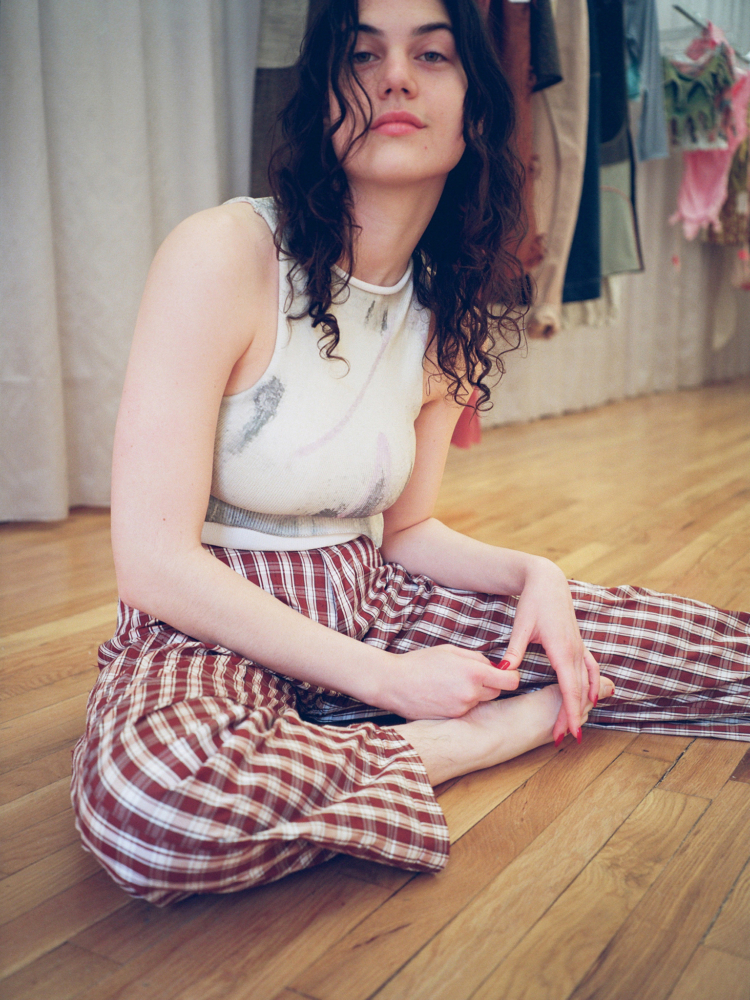
Shirt by Krystal Paniagua. Pants by CM Carney.
RUBINSTEIN: Do you plan to keep the team just the two of you?
HAAS: I feel like we’ll probably try to keep it that way for as long as possible.
RUBINSTEIN: When you guys came out of college, was it your plan to kind of just throw yourselves back into the New York fashion industry see what would come out of it? Or did you beeline towards opening your own space?
HAAS: We went to school together and Lucy was a year younger than me, so I had a year on my own living in the city. It’s something we’d always talked about, opening up a shop, but not really something that we… It was something we fantasized about. I wasn’t sure what I wanted to do for a little while. I thought about galleries, but that isn’t really for me. And then I quickly just started working retail, because I always really liked working in shops and being in shops—I worked at my friend’s vintage shop for a while. And then I think after like two years, I was frustrated, and I was like, “Let’s just try to do it.” There was so much support from the community and so many people wanted to see this project happen, which proved that it’s something that there’s need for. That was really helpful. I think that people should know that they can do things that seem really impossible. The hardest part is getting started.

